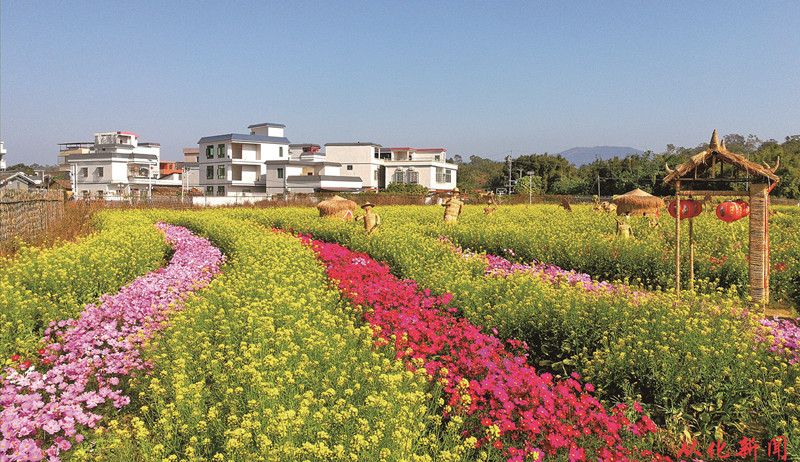Conghua included in 2021 national key counties of leisure agriculture

Conghua district in Guangzhou, capital of South China's Guangdong province, was included in the list of national key counties of leisure agriculture in 2021, together with other 59 county-level areas across the country. It is the only district in the list from Guangzhou.
The list, released by the Ministry of Agriculture and Rural Affairs recently, is a result of the ministry's work in building of key counties of leisure agriculture nationwide, and aims to build 300 such counties of national and international fame and influence by 2025. Conghua was included on the list, thanks to its unique natural resources, improved facilities and clear planning layout.
Unique natural resources
Conghua is hailed as "the pearl on the Tropic of Cancer". Its comprehensive air quality index and environmental competitiveness have consistently ranked top in Guangzhou for years. It has been placed among the top 10 green cities in China and has won the GEP special award of high-quality development list in the 2020 Guangzhou urban governance list.
Conghua has multiple forest parks and natural reserves at different levels, including the Liuxi River National Forest Park, Shimen National Forest Park, and Chenhedong Provincial Natural Reserve. It has abundant hot spring resources with a long development history. In 2010, Conghua hot spring was awarded the title of "world rare hot spring" by the World Federation of Hydrotherapy and Climatotherapy, sharing the acclaim with Davos Switzerland.
Conghua is also one of the birthplaces of Lingnan culture, and is home to plentiful ancient villages of high protection value, 20 of which are well-preserved and almost completely intact. The Guangyu Ancestral Temple, located in Qiangang village, won first place at the Award of Distinction in the UNESCO Cultural Heritage Conservation Awards in 2003. It is also a national key cultural relic protection unit.
In recent years, Conghua has held various national sports events such as the national mountaineering fitness conference, national camping conference, China mountain marathon series and the South China Historical Trail orienteering competition. The racecourse in Conghua is the first world-class racecourse in the Chinese mainland.
The district has five rural tourism routes at provincial-level and above, among which the routes themed around the hot spring and culture are at national-level. High-end B&B businesses have developed as a characteristic industry to stimulate rural vitality and the integrated development of primary, secondary and tertiary industries.
Improved facilities
To date, the district has built 458 kilometers of greenways, 60 kilometers of national demonstration mountaineering trails, 12 kilometers of demonstration section in Qiangang along the South China Historical Trail, and 6 kilometers of Liuxi water greenway. A total of 352.2 kilometers of country roads were built or renovated and 139 toilets have been built at tourist spots. The first city tourism distribution center in Guangzhou suburbs was also built in Conghua.
The district has nine demonstration bases for intangible cultural heritage inheritance, three revolutionary sites accredited as Guangzhou CPC history education bases, 10 study tour bases and eight literature and art service stations, covering all townships in the district.
Over the years, the district has built over 1,000 domestic sewage treatment facilities and was selected as a national pilot for the comprehensive treatment of rural water systems, ranking first in the province. All of the 221 villages in the district have achieved daily cleaning of domestic garbage.
Clear planning layout
The district has adopted a development ethos of integrating leisure agriculture with the construction of modern agriculture, ecological civilization and cultural industry, and formulated a progressive development model of "one belt, one center and three sections"(one belt is the rural tourism belt along the Liuxi River and the 105 National Highway; one center refers to the tourism service and transport distribution center; three sections are the cultural section with leisure agriculture characteristics, the premium fruits and flower section, and the eco-agriculture leisure section).
The district has implemented a series of actions plans that aim to build Conghua into a key leisure sightseeing agricultural and rural tourism destination in South China.
It takes leisure agriculture and rural tourism as pillar industries in propelling rural revitalization, and strives to build Conghua into an international hot spring tourism destination, a characteristic rural tourism destination and a well-known outdoor sports tourism destination in the Guangdong-Hong Kong- Macao Greater Bay Area.
To date, Conghua has built over 40 leisure agriculture and rural tourism scenic spots. There are nine sightseeing and leisure agriculture demonstration villages, seven sightseeing agriculture demonstration parks, and 33 agricultural parks, all at municipal-level. There are three national 3A rural tourist attractions, as well as nine characteristic towns, on the list of Guangdong characteristic towns, ranking first in Guangzhou.
Driven by leisure agriculture and rural tourism industries, there are 29,650 practitioners in leisure agriculture in 2020, including 23,810 farmers, with a farmer employment rate of over 80.3 percent.
The average farmers' income from leisure agriculture was 28,620 yuan ($4,410), an average growth rate of 3.7 percent over three years, from 2017 to 2019. The per capita income of farmers in the district is more than 5 percent higher than the average level in the province.
